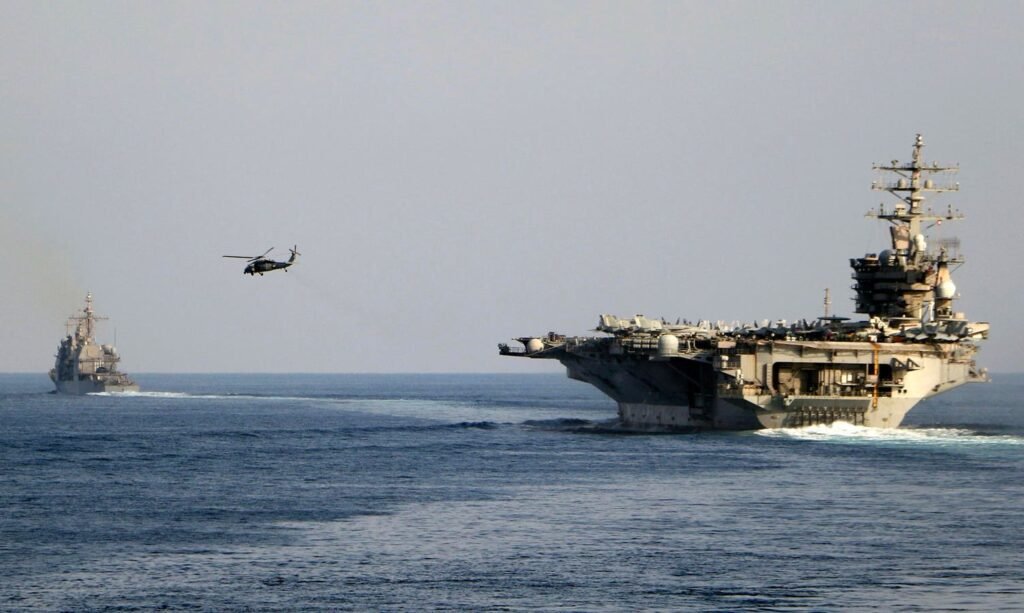The aircraft carrier USS Dwight D. Eisenhower and other warships are transiting the Straits of Hormuz … [+]
For more than a week, photos have been circulating on social media purporting to show the United States Navy’s nuclear power Nimitz-USS class hypercarrier Dwight D. Eisenhower (CVN-69) in port for repairs to damage sustained in the Red Sea after being hit by missiles fired by Houthi rebels in Yemen. At least one video also reportedly shows the carrier on fire after a direct hit.
According to the US Navy, the carrier is doing well. While it does remain deployed in the Red Sea to protect merchant shipping from drones and missiles fired by the Iran-backed group that controls large areas of Yemen, there are no confirmed reports that the vessel has been damaged.
However, it was on Thursday that the latest video making the allegations was posted on X, the social media platform formerly known as Twitter.
This was followed by another post by user @iAmTheWarax claiming that the carrier was forced to return to Crete for repairs.
“CONFIRMED: The Eisenhower (pictured docked for repairs in Souda Bay) was hit and severely damaged by multiple Houthi ballistic missiles. Judging by the extensive tent city being deployed on the flight deck, we believe it is unlikely that the Eisenhower will return to service in near future. “
@DrMansourMansou also shared a 30-second video clip earlier this week showing smoke rising above the flight deck after a missile or drone struck the vessel.
All of these posts—and more—have been debunked.
The most recent video was confirmed to have been taken more than a year ago while the USS Dwight D. Eisenhower docked at Pier 12 of Naval Station Norfolk in Virginia in April 2023, while the image claimed CVN-69 was in Crete it wasn’t even a US Navy ship. Rather, it was actually the flagship of the Russian Navy Admiral Kuznetsovwhich is undergoing repair at the 35th ship repair plant in Murmansk since 2018.
The video of the carrier on fire is believed to be taken from a video game. Users on social media have noted that the shape of the cockpit island is different from the US Navy Nimitz-class carrier.
Disinformation campaign
Social media posts have intensified since Houthi military spokesman Yahya Shari repeated the claim that the rebel group had successfully targeted the USS. Dwight D. Eisenhower and other warships in her carrier strike group last weekend. While it is easy for these images to be quickly debunked and dismissed in the United States, it is possible that in parts of the world they are considered fact.
While some of this may be laughable, it is part of a carefully orchestrated disinformation campaign.
“Misinformation and disinformation are certainly not new, but social media platforms have exacerbated this existing problem,” warned Dr. Julianna Kirschner, lecturer at the Annenberg School for Communication and Journalism at the University of Southern California.
“These platforms have no lag time and content can be written and/or uploaded quickly,” explained Kirschner. “This virtual landscape enables people to say the USS Eisenhower sunk in spite of reality. Attempts at humor are often the source of these claims, but sarcasm and tone are often lost on these platforms. Taken at face value, other users may believe they are experiencing new events when this is far from the truth.”
Easier than ever to fake misleading content
The big danger is that it’s easier than ever to manipulate videos and photos, and in a short time, it could be quite difficult to tell fact from fiction.
“Photo-swapping scams – as claimed by the Houthi attack – are fairly easy to debunk. The biggest problems and risks will come with more subtle and deep fake videos,” suggested tech industry analyst Charles King of Pund- IT. “For example, a video that slightly changes a political leader’s speech to make him appear older, uncertain or even depraved. If such videos were released just before an election, before they could be debunked, they could significantly influence preferences of voters.”
Misinformation relies on primacy or first impressions, making it harder to debunk, even if it seems impossible.
“It’s common for users to see images and videos that ‘prove’ these lies and believe them,” Kirschner said. “However, when later presented with contrary and true information, the same group of people may double down. Psychologically, they do not want to admit that they have been deceived, or perhaps they do not realize that they have been deceived. Thus, they continue to promote their first impression as fact despite This is especially true when disinformation and disinformation support the users’ pre-existing ideology, as in the case of Yemen and Iran.
Another unprecedented aspect of social media’s influence in spreading this kind of misinformation is the potential size of the audience.
“Anyone can post nonsense at any time. However, whether their content reaches a significant audience size is debatable,” Kirschner continued. “However, the potential is always there, so users and bot owners are putting out false social media content in hopes of reaching a detectable audience. If they have access to posts like these in Yemen and Iran or anywhere else for that matter topic , we should all be concerned if the supremacy result is any indication, the damage these posts create will be hard to undo.
